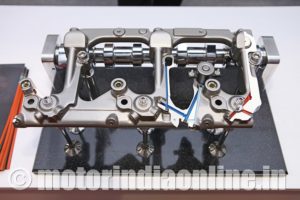Jacobs Vehicle Systems focuses on solving critical performance challenges with forward-thinking technology for engine retarding, emissions, and positive power levels
Since 1961, Jacobs Vehicle Systems has designed and manufactured over seven million engine brakes for commercial vehicles around the globe. By 2020, the Indian marketplace will upgrade its braking regulation (IS-11852) to harmonize with the international standards, and Endurance Braking Systems will become mandatory on every commercial vehicle and bus from 12 tonnes and above. Jacobs’ products provide the necessary technology to allow these vehicles to comply with the upcoming regulatory requirements. Essentially, the engine brake provides supplemental retardation and helps a vehicle to slow down over a shorter distance than a vehicle equipped only with foundation brakes. This also means a vehicle coming down a hill can maintain a constant speed without engaging the foundation brakes, points out Mr. Kunal Sharma, Country Manager – India, commenting on the above subject.

Excerpts:
Safety features and highlights in applications
As mentioned above, our products help the vehicles to meet the government safety regulation regarding endurance braking system. Our engine brakes increases overall braking effectiveness of the vehicle, limits Brake Fade caused to heating of foundation brakes, increase brake liner life by 3x – 5x times, reduces the driver fatigue and improves overall productivity. The use of engine brakes help the vehicle to drive- faster, with better downhill control and longer, eliminating the need to stop to cool the foundation brakes. In laymen’s context, an engine brake pays for itself in 6 months to 1 year time (OR The ROI on engine brake is 6 months to 1 year OR The additional cost incurred on engine brake is recovered within 6 months to 1 year of utilization)
Safety apprehensions at higher road speeds
This will be a welcome change. Higher speeds necessarily do not mean more accidents. Compare the German Motorways with no speedways or the highways in the US with a min. speed requirement. You see lesser accidents than on our roads and the reasons are plenty. Drunken driving, slow speeds in fast lane, rapid and reckless lane changing, no tail lamps during night times, absence of adequate endurance braking for trucks and buses while coming downhill and many more.
If the Government is able to upgrade and provide the infrastructure, the country will automatically need higher speeds. An engine brake from Jacobs will provide more safety to the commercial vehicle segments and help them safely go faster!
Technology impact on safety in the times ahead
There will added impetus and significance of vehicle-assisted safety features as markets begin to consider autonomous vehicles (or driver assisted vehicles). Engine braking becomes a critical piece of the aspect of slowing a vehicle. With proper control algorithms, engine-braking mode can be automatically initiated by the ECU. The ECU could also trigger transmission shifts (with auto or auto-manual transmissions) to dial in the engine RPM for engine braking performance optimal to the driving conditions or situation. The ECU can control how the engine brake assists the driver in the driving conditions, improving comfort, control and productivity. Additionally, brake blending is a strong consideration for the future, with the ECU determining the appropriate combination of applying the various brakes and retarders on the vehicle for optimal and safe control of the vehicle.
